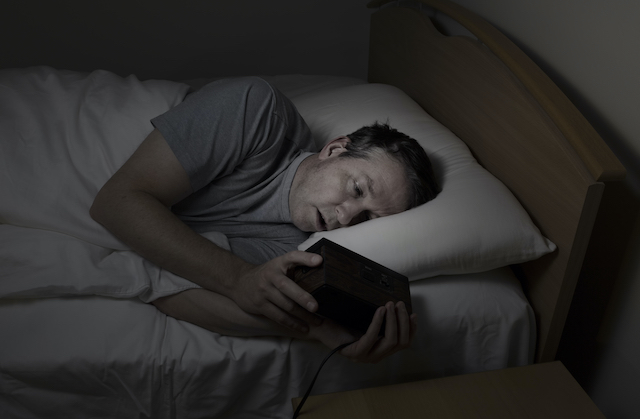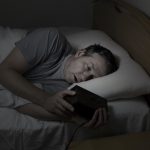How Your Lifestyle and Daily Habits Affect Sleep Apnea
Posted by Dr. Michael Breus

Talking about lifestyle and sleep apnea is really a two-part discussion. The lifestyle choices we make can affect risk for sleep apnea, how the sleep disorder progresses, and how well we respond to treatment. And sleep apnea itself has a powerful impact on daily living. Sleep apnea:
- Deprives us of sound, restful, restorative sleep
- Depletes energy, creates fatigue and daytime sleepiness that impairs daily functioning
- Compromises cognitive performance
- Hurts emotional health, triggering irritability, stress and raising risks for chronic anxiety and depression
Think for a moment about the impact of these challenges across the spectrum of your daily life. Relationships, health, and performance are all compromised. Often people with OSA don’t know they have the sleep disorder. That leaves them unable to function at their best, feeling tired and run down, experiencing conflict in relationships, not having the energy and focus they need for work and the other important aspects of life, all without understanding the root cause: sleep disordered breathing.
When sleep apnea goes untreated, frustration, self-judgment and shame often grow, as people struggle with an unrecognized health disorder, and lack the treatment and support that can return them to living with vitality and energy.
I’m going to talk first about some of the habits and patterns of daily life that contribute to sleep apnea and then dig in to how our lifestyle choices and habits can improve sleep apnea and its symptoms.
Lifestyle risks for sleep apnea
Weight gain
Obesity is a prime risk factor for sleep apnea. Not everyone who has OSA is overweight. But many are—an estimated 70% of people with sleep apnea are overweight or obese. The higher the level of obesity, measured with body-mass index, or BMI, the greater a person’s risk for sleep apnea becomes.
In a difficult and frustrating cycle, the presence of sleep apnea can cause people to gain additional weight, which can worsen the condition and its symptoms. The connection between disrupted sleep and weight gain is clear and well established. When we don’t get enough sleep, and when sleep is restless and fragmented, we’re much more prone to gaining weight. When we’re tired, our energy for physical activity goes down, and we tend to become more sedentary. Poor sleep also triggers significant changes to hormones that regulate hunger and metabolism. Appetite goes up, especially for foods that contribute to weight gain, including sugary, starchy foods and heavily processed “junk foods” that are filled with unhealthful fats. Disrupted sleep heightens activity in the brain’s reward centers—specifically in areas that respond to stimulation from food. Short on sleep, our brains “light up” with desire for the very foods that cause weight gain.
In a person with mild sleep apnea, a 10% weight gain increases by 6 times the risk that their sleep apnea will become more severe, according to research. Additional weight also puts a strain on the cardiovascular system, and further increases risks for the chronic health conditions associated with OSA, including high blood pressure, heart disease, and diabetes.
Snoring
Snoring is the most common form of sleep-disordered breathing. It can be easy to overlook snoring as nothing more than a nuisance. But snoring should never be dismissed or ignored. Snoring interferes with both quality and quantity of sleep for the snorer themselves and it’s a major cause of sleep disruption for bed partners.
Snoring can be brought on by a number of factors, including:
Age: as we grow older, we’re more likely to snore
Weight: being overweight substantially increases likelihood of snoring
Substance use: alcohol and nicotine can both contribute to snoring, by affecting the muscles and tissues of the upper airway
Sleeping on your back: A back sleeping position compresses the airway and leads many people to snore (try a side sleeping position to alleviate airway compression and breathe more normally during sleep)
Anatomical structure: Individual characteristics, from a narrow airway to a long soft palate to large tonsils, can make a person more likely to snore
Snoring is a hallmark symptom of sleep apnea. It’s estimated that about 50% of people who snore have OSA.
It’s impossible to know whether your snoring is a symptom of underlying sleep apnea without an evaluation. Many factors can be in play at once, with age, weight gain, and other lifestyle factors such as smoking and alcohol consumption contributing to snoring and, over time, to sleep apnea. That’s why it’s so important to address any snoring issue, rather than just putting up with it (and asking your partner to do the same). Early and prompt attention will improve your sleep and can get you the treatment you need if sleep apnea is the underlying cause of your snoring.
Smoking
There’s a strong association between smoking and sleep apnea. People who smoke are more likely to have more severe OSA than former smokers and nonsmokers. And there’s evidence that suggests smoking may be a contributing cause of sleep apnea. There are a number of ways that smoking may contribute to sleep apnea:
- By creating inflammation in the upper airway (via smoke inhalation), narrowing the passage for normal, unobstructed breathing
- By relaxing the muscles of the upper airway (an effect of nicotine), increasing the likelihood of airway collapse during sleep
- Through the arousing effects of nicotine, a stimulant, which can alter normal sleep cycles and contribute to lighter, more fragmented, less restful sleep
Quitting smoking will improve your sleep and is likely to lead to a reduction in sleep apnea symptoms. Research shows that people who quit smoking can significantly reduce their risk for sleep-disordered breathing.
How lifestyle choices can improve OSA
The good news? Making changes to lifestyle habits can significantly improve sleep apnea. These changes often need to take place in conjunction with prescribed treatment for sleep-disordered breathing—most often, that treatment is CPAP. Anyone who’s experiencing disordered breathing, or any of the symptoms of OSA should be screened and diagnosed by a physician, to receive the most appropriate and effective treatment for their individual condition. These lifestyle choices can enhance the treatment of OSA alongside CPAP and other therapies that a doctor prescribes.
Losing weight
Moderate weight loss can make a big difference in sleep apnea. Losing 10% of body weight can lead to a 20-30% reduction in the severity of OSA, according to research. Losing weight also directly improves the quality of sleep in people who are overweight and obese.
There’s a positive cycle that kicks in when sleep apnea is treated effectively with CPAP. That’s because sleeping better can make losing weight easier. Sleep regulates appetite hormones and lowers activity in the brain’s reward centers. This leads to a greater sense of satisfaction and satiety, and fewer cravings for sugary, starchy, weight-loss busting foods. Sleep helps regulate blood sugar and keep insulin working effectively. Conversely, poor sleep impairs insulin’s effectiveness, and contributes to elevated blood sugar. Losing weight can help reduce the risk of diabetes, which appears frequently as a co-occurring condition with sleep apnea.
Increasing exercise
Physical activity is of course an important component of losing weight and maintaining a healthy weight. Exercise can reduce the severity of sleep apnea. Beyond weight loss, exercise has additional benefits that may help reduce the severity of sleep-disordered breathing, improving sleep and daytime functioning.
- Exercise may improve muscle tone in the upper airway. There’s some evidence indicating that exercise may strengthen the muscles of the airway, increasing airway stability and making the airway less prone to impairing breathing during sleep.
- Exercise may reduce fluid build-up in the neck. When we lie prone during sleep, fluid travels from the lower body and pools in the neck. This accumulation of fluid puts additional pressure on the airway and can worsen the severity of sleep apnea. Being sedentary during the day can increase this nighttime fluid shift—but there’s research indicating that exercise may help diminish the gathering of fluid in the neck at night, alleviating some of that pressure that contributes to apneas.
- Exercise increases deep, slow-wave sleep. People with OSA take longer to reach their first phase of deep sleep and spend less time in deep sleep over the course of a night. Deep, slow-wave sleep is critical for the body’s immune strength, for rebuilding and repairing cells and tissues, for maintaining a healthy metabolism. Exercise increases time in slow-wave sleep. In people with sleep apnea, research has found that regular moderate exercise increases deep sleep amounts.
A strong body of research has shown that the combination of weight loss and regular exercise can be highly effective in improving sleep apnea, for people with all levels of the sleep disorder, from mild to severe.
Practicing mindfulness meditation
This is one of my favorite lifestyle changes for anyone with sleep issues, particularly people with sleep apnea. Mindfulness therapy doesn’t get talked about enough as a tool to reduce symptoms and improve quality of life for people with OSA. In my work with patients with sleep apnea, mindfulness meditation is a core strategy we use. (I also use it in my own life!) The practice of mindfulness meditation is simple and powerful.
Mindfulness is a practice of gently focusing one’s attention and awareness on the present moment. In a mindful state, we allow ourselves to be aware of any thoughts, feelings, and physical experiences that occur, as well as to be aware of the environment that surrounds us. This moment-to-moment awareness is accompanied by a non-judgmental acknowledgement of any and all thoughts and feelings. When we practice mindfulness, we accept all thoughts and feelings as they come and go, assigning no judgment or criticism to them—or to ourselves for having them.
Mindfulness meditation can reduce fatigue, depression, anxiety and insomnia—all conditions that frequently occur in conjunction with sleep apnea. Mindfulness meditation activates the parasympathetic nervous system, our “rest and digest” system. Sleep apnea creates excess stimulation in the sympathetic nervous system—that’s the “fight or flight” system, which elevates heart rate and blood pressure, puts additional stress on the cardiovascular system and the immune system, and disrupts hormone balance. Stimulating the parasympathetic nervous system through mindfulness meditation can reduce heart rate and blood pressure, lower stress, and help return hormones to optimal levels.
Mindfulness meditation also makes treatment for sleep apnea easier and more successful. Research shows that practicing mindfulness meditation helps people use their CPAP more consistently. That’s going to improve sleep apnea, diminish its side effects, and help reduce risks for secondary health problems, including heart disease, depression, anxiety, and cognitive issues.
Simple breathing exercises are an excellent way to incorporate mindfulness mediation into your daily routine. You can do this anytime, anywhere. Here’s a simple breathing exercise I share with my patients:
The 4-6-7 breathing technique
- Breathe in for a count of 4 seconds
- Hold breath for 6 seconds
- Breathe out for 7
You can use this breathing exercise to bring yourself to a resting, in-the-moment state of mindfulness. This will lower your heart rate, activate your “rest and digest” nervous system, and reduce stress. Use this breathing exercise throughout your day, and before bed, and your sleep will be more restful. Most of my patients find that employing this exercise helps them begin to pay attention to their breath—and their state of mindfulness—more frequently all day long. For people with OSA, greater attention to breath and mindfulness during the waking day can be powerfully relaxing and focusing, and can translate into an easier transition to sleeping with CPAP at night. And that means better, more restful, more physically and mentally restorative sleep. Sleep apnea is a complex sleep disorder that needs medical attention. But the lifestyle choices we make every day can make a huge difference in how well treatment works to control and alleviate OSA, its symptoms, and side effects.







